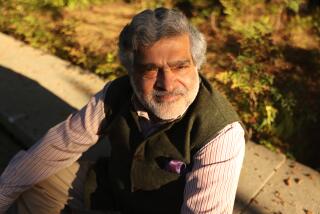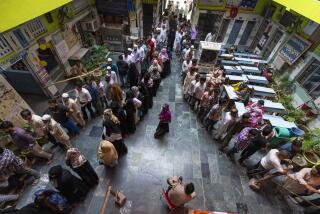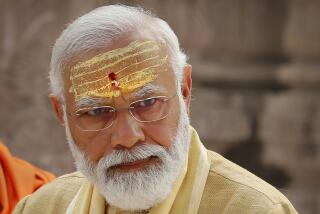Battle of Gandhis Heats Up in Heartland : India: They share the same last name and a legacy as grandsons of national heroes. But Rajiv and Rajmohan share little else on campaign trail.
- Share via
AMETHI, India — Not far from the billion-dollar fertilizer factory and the hi-tech jet simulators at the Indira Gandhi Flying Academy--indeed, just a few miles off the paved roads that Prime Minister Rajiv Gandhi has lavished on his celebrated electoral district--Rajmohan Gandhi stood in a clearing near the broken-down village well, surrounded by the poorest of India’s poor.
This was the other India, the wide-eyed farmers and shepherds were told by Rajmohan’s campaign workers, the real India that the prime minister’s largess has left behind.
And this rumpled and quixotic candidate wearing a simple garland of marigolds and white cloth, they were told, was the other Gandhi--the real Gandhi.
When at last he spoke through a crude, battery-powered megaphone, Rajmohan Gandhi, grandson of India’s legendary champion of freedom, Mohandas K. Gandhi, made it clear why the Indian nation had dubbed this crucial race, “Gandhi vs. Gandhi: The battle of the grandsons.”
“The values that Mahatma Gandhi stood for have been flouted,” he told the dirt-poor villagers. “The values that Jawaharlal Nehru stood for also have been flouted. And it is Nehru’s own grandson, Rajiv Gandhi, who has done this to us.
“If we are to attain these ideals, Rajiv Gandhi must go. He has hurt the honor of the nation by his involvement in corruption. He has hurt the democratic institutions. He has gathered power in his own hands,” he added. “I do not compare myself to my grandfather. He was a saint and a revolutionary, and I am just an ordinary man. But I have chosen to walk his road.”
The course Rajmohan Gandhi has chosen is no less than a frontal assault on India’s beleaguered prime minister right in his own citadel, Rajiv Gandhi’s parliamentary constituency. The prime minister must win this parliamentary seat during three days of national voting that begins next week if he is to hope to continue governing what is widely hailed as the largest democracy on Earth.
And for most of the Indian nation, the battle for this 100-square-mile slice of the Indian heartland called Amethi has become symbolic of the key issues in the nation’s most hotly contested general election ever--Rajiv Gandhi’s five-year record versus the opposition’s charge that the government he inherited from his murdered mother in a 1984 wave of sympathy is now corrupt, inept and far-removed from the realities of today’s grass-roots India.
For Vishwanath Pratap Singh, Rajiv Gandhi’s former defense minister who now heads the increasingly popular National Front coalition of opposition parties, the race in Amethi is an allegory, a staged confrontation between the old-fashioned Gandhian morality of the Mahatma and the big-money, hi-tech power of India’s long-ruling Nehru dynasty. The Nehru dynasty is unrelated to the Mahatma and acquired the Gandhi surname only after Nehru’s daughter, Indira, married an obscure politician named Firoze Gandhi.
“It is the real Gandhi versus the fake Gandhi,” Singh said. “Rajmohan is the best symbol of our struggle to restore the values of dignity to the country, values which have gotten eroded under this government.”
Independent analysts have gone a step further.
“We’re saying the Amethi election is symbolic of the entire struggle for democracy,” said Rajni Kothari, a prominent Indian political analyst who, like most of India’s intellectuals, believes the time has come to end the rule of one of the modern world’s longest-lived family dynasties.
“Here you have Rajmohan Gandhi, a dedicated human-rights worker, going up against a prime minister with a foreign wife and an alien government, which is running a campaign of money power under a cloud of corruption.”
Echoing the analysts, India’s prestigious English-language daily newspapers also have turned against Gandhi and his ruling Congress-I party, most of them giving wide coverage to charges that the prime minister personally profited from tens of millions of dollars in commissions paid in a $1.3-billion arms deal with the Swedish armaments firm, Bofors.
Commenting on the Amethi race, the prestigious national daily, the Times of India, ran a front-page cartoon recently depicting the ghosts of Mahatma Gandhi and former Prime Minister Jawaharlal Nehru sitting on two clouds in heaven.
“I hear my grandson is fighting to save the country,” the Mahatma tells Nehru. “And yours?”
“Just fighting,” Nehru replies.
Clearly, Rajiv Gandhi and his ruling Congress-I party are fighting for their political lives in what already is the most sophisticated and costly election campaign in Indian history. By any account, Gandhi’s party is spending tens of millions of dollars on its nationwide fight to win a majority of India’s 545 parliamentary seats.
And nowhere is that largess more visible than in Amethi, where Rajiv Gandhi buttons, posters, flags, calendars and other slick paraphernalia are being doled out by the thousands.
Every day, scores of factory-new jeeps, all fluttering the green, saffron and white of the Congress-I flag, zip around the roads and dusty tracks of the sprawling district, blaring Rajiv campaign slogans through state-of-the-art audio systems.
To woo the vote, the ruling party has given away hundreds of campaign videocassettes and, the opposition charges, even free television sets.
Such gifts are not new to Amethi, which has received more government pork-barrel projects than any other district in the nation since 1981, when Rajiv Gandhi won the seat that had been held by his brother Sanjay before his death in a plane crash.
There is the $1-billion fertilizer plant, which provides 6,000 jobs. There are now 15 large and 1,231 small-to-medium factories, and there’s the Indira Gandhi Flying Academy, India’s only world-standard civilian facility for commercial-pilot training, which is located inexplicably amid villages that lack basic electricity.
“How can Amethi possibly vote against Rajiv Gandhi after all he has given them?” asked retired Indian Airlines pilot Capt. Satish Sharma, a close friend of Rajiv, himself a former pilot, and the man Gandhi has selected to run his Amethi campaign.
“But it’s not just all this development,” Sharma added. “It’s the rapport that Rajiv has built up with these villagers. You know, in these remote villages, they call him Rajiv Bhaiya-- elder brother Rajiv.
“And don’t believe all this bad press about Sonia Gandhi, either. Here they treat his wife as part of the family, also.”
Indeed, it is Gandhi’s Italian wife, Sonia, and their 17-year-old daughter, Priyanka, who have shouldered the bulk of the village-to-village campaigning in Amethi for the prime minister, who has been far too busy with a dizzying schedule of helicopter, jet and limousine campaign tours for his party’s candidates around the nation.
Despite Sharma’s boastful confidence, it remains unclear just how effective he and the Gandhi women have been as campaigners. And, in spite of analysts’ consistent predictions that Rajmohan’s austere campaign will never overcome Rajiv’s massive largess, Amethi’s peasants themselves are questioning just how secure the prime minister actually is in his own constituency.
Ram Bahadu Sarooj is a typical example. He is the sarpanch , or village head man, of Digha, a hamlet of mud-and-straw huts 10 miles from any semblance of a road and home to about 900 peasant farmers.
It is in such remote villages that most of Amethi’s 900,000 voters live. And it is here that Rajiv Gandhi’s campaign manager, Sharma, said one must look “to see what Amethi really thinks of Rajiv.”
But Sarooj, a member of Hinduism’s long-oppressed Untouchable caste that is a traditional Congress-I vote bank, didn’t really think much at all about Rajiv.
“We don’t know him here,” Sarooj said through a translator. “Sonia Gandhi came here yesterday. She spoke some few words to us. She gave us these calendars and campaign buttons. Then she left.”
On the morning after, though, the First Lady’s gifts appeared as alien to Amethi as the sophisticated Indira Gandhi Flying Academy. Several Rajiv calendars were hanging upside down on mud walls and mothers had used the slick campaign buttons to close rips in their children’s ragged shirts.
It was just down the road from Digha that Rajmohan Gandhi was touring that day. In fact some of the children at his small, public meetings were wearing the buttons that Sonia Gandhi had doled out the day before--most of them upside down.
“In the times of the British, when the colonial powers got their foothold, they used mirrors and beads to dazzle us into following them blindly,” Mahatma Gandhi’s grandson shouted through his jerry-built sound system. “Today, these glossy posters and fancy buttons are the mirrors and beads of this day and age--the trinkets Rajiv is using to gain his foothold here.”
In an interview beside the broken village well after his speech ended, the “other” Gandhi insisted he does have a chance against Rajiv and Congress-I’s millions.
“Ferdinand Marcos also lavished largess on his followers, but in the end Marcos failed,” he said, referring to the late Philippine leader who was ousted in 1986. “Largess only succeeds for some time. And the Marcos example is very much valid here. You see all these buttons and posters, but there isn’t a single high school for 15 miles around this place.”
Back in Digha, outside sarpanch Sarooj’s hut, there was independent evidence that Rajmohan may well be right.
Asked what the prime minister has done for Digha, which has no power, no schools, no paved roads and, in short, resembles most of rural Amethi, the sarpanch smiled and said: “You can see what is the condition of my village. And it has always looked this way.”
More to Read
Sign up for Essential California
The most important California stories and recommendations in your inbox every morning.
You may occasionally receive promotional content from the Los Angeles Times.













